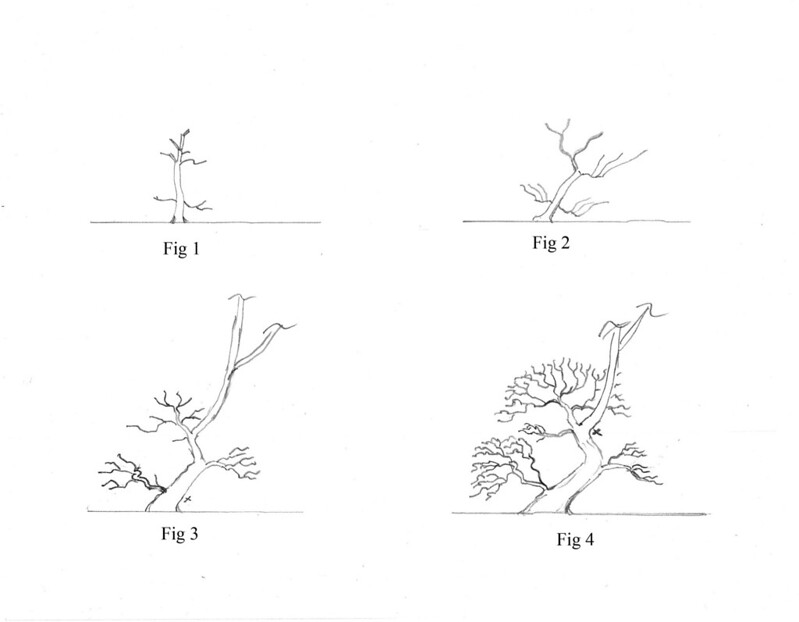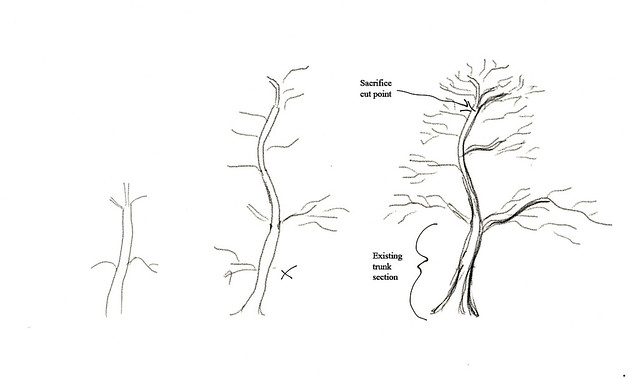Eric Schrader
Chumono
grow grow grow
I'm not sure how your local conditions allow for growth - is your season quite short?
One thing I would say is that people tend to take the short-term approach for the long-term with bonsai. There is this mis-conception that the trees you see in photos in books and magazines from Japan were just always grown in a small container and managed to get big anyway. Nothing could be farther from the truth. Trees are trained in the ground, in large boxes, in large bonsai pots etc., until the trunk is large and the primary branches have at least been set in place if not many secondaries as well. Don't put a tree in a small pot unless you want it to grow very slowly. Also, don't follow the pinch, cut, pinch method you read about in magazines unless you have a tree with a trunk and branches as large and long as you want them to be.
Here's what I think you should do with this tree:

Figure 1: your tree about as-is. It is small, with limited bonsai development. The trunk is nearly vertical.
Figure 2: Your tree Planted at about a 60 degree angle and showing about a year worth of good growth. To accomplish this I would put it in a large box or pot and allow it to establish a large root system. Train all new growth with wire, do not pinch any tips or restrict growth in any way during the first year.
After a year in a large container transplant the tree at the same angle into the ground if you can. Edit the roots when placing the plant in the ground. Continue training. Choose a strong shoot near the top of your tree to be a sacrifice branch. Choose it such that when it is removed the cut is vertical rather than horizontal and preferably so it is on the back of the tree. Allow the sacrifice branch to grow without cutting or pruning of any kind.
A second strong shoot from the previous top should be trained into a new trunk section and top; adding a second trunk section would improve this material by increasing the movement and taper. Allow the sacrifice branch to grow while keeping control over the other branches. Wire all new growth that is not part of the sacrifice branch.
Figure 3: After 3-5 years depending on how well you get it to grow your sacrifice branch should be well-established and fattening the trunk. You should continue developing the finished branches by controlling their growth carefully. With a strong sacrifice and in the ground it may be difficult to control them completely but do the best you can. If the smaller branches get weak you can cut back some of the sacrifice branch to re-establish balance but this will slow development of the trunk. Keep an eye on the roots - if one is getting particularly large you can cut it to force development of more fine roots near the trunk.
Figure 4: After 7-10 years you should have a significantly improved trunk. With some luck you may have a good branch structure as well. The "X" in the drawing indicates where I would remove a sacrifice. Note that it shouldn't typically be allowed to grow from higher than about 2/3 up the height of the finished tree (the position shown would be ideal but slightly lower would be fine too).
Good Luck and good growing!
I will post a picture when it grows some
I'm not sure how your local conditions allow for growth - is your season quite short?
One thing I would say is that people tend to take the short-term approach for the long-term with bonsai. There is this mis-conception that the trees you see in photos in books and magazines from Japan were just always grown in a small container and managed to get big anyway. Nothing could be farther from the truth. Trees are trained in the ground, in large boxes, in large bonsai pots etc., until the trunk is large and the primary branches have at least been set in place if not many secondaries as well. Don't put a tree in a small pot unless you want it to grow very slowly. Also, don't follow the pinch, cut, pinch method you read about in magazines unless you have a tree with a trunk and branches as large and long as you want them to be.
Here's what I think you should do with this tree:

Figure 1: your tree about as-is. It is small, with limited bonsai development. The trunk is nearly vertical.
Figure 2: Your tree Planted at about a 60 degree angle and showing about a year worth of good growth. To accomplish this I would put it in a large box or pot and allow it to establish a large root system. Train all new growth with wire, do not pinch any tips or restrict growth in any way during the first year.
After a year in a large container transplant the tree at the same angle into the ground if you can. Edit the roots when placing the plant in the ground. Continue training. Choose a strong shoot near the top of your tree to be a sacrifice branch. Choose it such that when it is removed the cut is vertical rather than horizontal and preferably so it is on the back of the tree. Allow the sacrifice branch to grow without cutting or pruning of any kind.
A second strong shoot from the previous top should be trained into a new trunk section and top; adding a second trunk section would improve this material by increasing the movement and taper. Allow the sacrifice branch to grow while keeping control over the other branches. Wire all new growth that is not part of the sacrifice branch.
Figure 3: After 3-5 years depending on how well you get it to grow your sacrifice branch should be well-established and fattening the trunk. You should continue developing the finished branches by controlling their growth carefully. With a strong sacrifice and in the ground it may be difficult to control them completely but do the best you can. If the smaller branches get weak you can cut back some of the sacrifice branch to re-establish balance but this will slow development of the trunk. Keep an eye on the roots - if one is getting particularly large you can cut it to force development of more fine roots near the trunk.
Figure 4: After 7-10 years you should have a significantly improved trunk. With some luck you may have a good branch structure as well. The "X" in the drawing indicates where I would remove a sacrifice. Note that it shouldn't typically be allowed to grow from higher than about 2/3 up the height of the finished tree (the position shown would be ideal but slightly lower would be fine too).
Good Luck and good growing!


